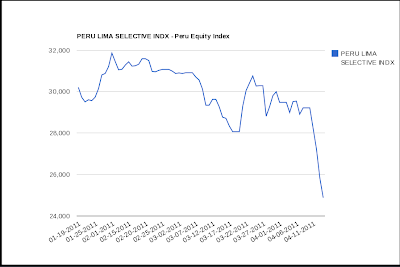Here's a US News and World Report article that was just posted on Yahoo:
Why You Should Buy US Treasuries
Reading that article makes me want slather on some red,white and blue body paint before cruising on over to the local WalMart in my Ford F150 with Toby Keith blaring on the radio. Yes, America and Americans have had many great achievements over the past 100 years but unfortunately "past results do not guarantee future performance." Rarely in the history of the world did a country find itself in a position to achieve unbelievable growth the way the U.S did following World War 2. There was insatiable demand: the infrastructure for a good portion of the world having just been blown to smithereens, coupled with incapacitated supply: the production capabilities of the majority of industrialized nations had also been pulverized. So the U.S., almost completely untouched by hostilities, is able to export trillions of dollar of products and services over the next 40+ years. When the rest of the World has finally caught up in the 90s, America starts on a debt binge in an attempt to maintain the status quo. We remain in that debt-fueled phase today, some 20 years later.
Thursday, April 14, 2011
Peruvian Stock Market Down 25%
The Peruvian stock market has taken it on the chin over the last 2 months with a drop of over 25%.

The markets are concerned about the possibility of the left-wing candidate winning the run-off election in June. That kind of move might serve to galvanize the pro-business voters to get out to the polling booths.

The markets are concerned about the possibility of the left-wing candidate winning the run-off election in June. That kind of move might serve to galvanize the pro-business voters to get out to the polling booths.
Tuesday, April 12, 2011
Meritocracy... uh, yeah right
From Matt Taibbi over at Rolling Stone:
The Real Housewives of Wall Street
Here's the money shot:
This incident is emblematic of the governance of the U.S. financial system. As a U.S. citizen, if this doesn't get your blood boiling with regards to the handling of the financial crisis of 2008, then you must be part reptile. In order to avoid a short term destabilizing economic event, the fed throws money around indiscriminately in the hopes that some of it happens to land in the right place. It brings to mind the image of a firefighter trying to extinguish a fire by spinning around on a carousel while blindfolded. This is the dark side of having a fractional reserve lending system; our banking system is always a hair's width away from a major disruption. I'm not going to get into a full on discussion of the pros/cons of frac-res lending, but suffice it to say that with the small amount of reserves that banks keep on hand, it requires someone else to act as a very big backstop if there ever happens to be a run on deposits.
The Real Housewives of Wall Street
Here's the money shot:
It's hard to imagine a pair of people you would less want to hand a giant welfare check to — yet that's exactly what the Fed did. Just two months before the Macks bought their fancy carriage house in Manhattan, Christy and her pal Susan launched their investment initiative called Waterfall TALF. Neither seems to have any experience whatsoever in finance, beyond Susan's penchant for dabbling in thoroughbred racehorses. But with an upfront investment of $15 million, they quickly received $220 million in cash from the Fed, most of which they used to purchase student loans and commercial mortgages. The loans were set up so that Christy and Susan would keep 100 percent of any gains on the deals, while the Fed and the Treasury (read: the taxpayer) would eat 90 percent of the losses. Given out as part of a bailout program ostensibly designed to help ordinary people by kick-starting consumer lending, the deals were a classic heads-I-win, tails-you-lose investment.
This incident is emblematic of the governance of the U.S. financial system. As a U.S. citizen, if this doesn't get your blood boiling with regards to the handling of the financial crisis of 2008, then you must be part reptile. In order to avoid a short term destabilizing economic event, the fed throws money around indiscriminately in the hopes that some of it happens to land in the right place. It brings to mind the image of a firefighter trying to extinguish a fire by spinning around on a carousel while blindfolded. This is the dark side of having a fractional reserve lending system; our banking system is always a hair's width away from a major disruption. I'm not going to get into a full on discussion of the pros/cons of frac-res lending, but suffice it to say that with the small amount of reserves that banks keep on hand, it requires someone else to act as a very big backstop if there ever happens to be a run on deposits.
Sunday, April 10, 2011
New Update Complete
We've just updated the website and we're going to highlight some of the new features over the next few posts.
Several new charts have been added/enhanced including this one:
http://www.pikefin.com/phptest/charts/equities/epslinechart3.php?entityid=1

The top chart shows actual earnings and estimated earnings by calendar quarter (rather than fiscal quarter; this makes it easier to make comparisons between companies with different fiscal schedules).
The bottom chart is also actual earnings and estimated earnings but with 2 differences - share price is being shown and all 3 metrics are being shown in terms of percentage change.
Right now we have data for the S&P 500. There are plans to expand the US equity offerings as well as to offer global equities.
Several new charts have been added/enhanced including this one:
http://www.pikefin.com/phptest/charts/equities/epslinechart3.php?entityid=1

The top chart shows actual earnings and estimated earnings by calendar quarter (rather than fiscal quarter; this makes it easier to make comparisons between companies with different fiscal schedules).
The bottom chart is also actual earnings and estimated earnings but with 2 differences - share price is being shown and all 3 metrics are being shown in terms of percentage change.
Right now we have data for the S&P 500. There are plans to expand the US equity offerings as well as to offer global equities.
Saturday, April 2, 2011
Website Technical Update
We're working hard on adding new functionality and charts to the website which you can access here: http://www.pikefin.com
Here's a list of some items that will be showing up soon:
-a new earnings per share chart for S&P 500 equities that will show estimated and actual earnings per share growth along side stock price.
-a new input control for selecting entities (stock, forex cross, commodity, etc.) in the individual line charts.
-new alert manager charts that will enhance the monitoring of alerts.
We are also in the process of adding a registration page for the alert manager, but in the meantime if you are interested in setting up an account (which is free), just email pikefin1@gmail.com.
"What is this alert manager?" might be the next logical question. The alert manager is a web site that allows for the tracking and notification of numerical data for different financial entities - e.g. stocks, commodities, global equity indexes and commodities, with plans for additional entities in the future. As an example, let's say someone wanted to be notified if gold futures gained or lost 20% over the next year. They would be able to set up the following criteria in an alert:
metric: price
entity: gold future
% threshold: .20
time frame: 1 year
If the price of gold ends up meeting or exceeding the threshold over the defined period, the next step is to notify the user. We provide several notification formats for a user to choose from: email, SMS, twitter or by checking the website. We also have an android application in the works with future plans for an iphone app.
Some other examples of entity/metric combinations currently available: (not an exhaustive list) country/gdp estimate, us equity/stock price, us equity/eps estimate, global equity index/price. There are plans for many more metrics such as unemployment rate and housing starts as well as plans for new entities like bonds and individual global (outside of the US) equities.
Here's a list of some items that will be showing up soon:
-a new earnings per share chart for S&P 500 equities that will show estimated and actual earnings per share growth along side stock price.
-a new input control for selecting entities (stock, forex cross, commodity, etc.) in the individual line charts.
-new alert manager charts that will enhance the monitoring of alerts.
We are also in the process of adding a registration page for the alert manager, but in the meantime if you are interested in setting up an account (which is free), just email pikefin1@gmail.com.
"What is this alert manager?" might be the next logical question. The alert manager is a web site that allows for the tracking and notification of numerical data for different financial entities - e.g. stocks, commodities, global equity indexes and commodities, with plans for additional entities in the future. As an example, let's say someone wanted to be notified if gold futures gained or lost 20% over the next year. They would be able to set up the following criteria in an alert:
metric: price
entity: gold future
% threshold: .20
time frame: 1 year
If the price of gold ends up meeting or exceeding the threshold over the defined period, the next step is to notify the user. We provide several notification formats for a user to choose from: email, SMS, twitter or by checking the website. We also have an android application in the works with future plans for an iphone app.
Some other examples of entity/metric combinations currently available: (not an exhaustive list) country/gdp estimate, us equity/stock price, us equity/eps estimate, global equity index/price. There are plans for many more metrics such as unemployment rate and housing starts as well as plans for new entities like bonds and individual global (outside of the US) equities.
Subscribe to:
Posts (Atom)
